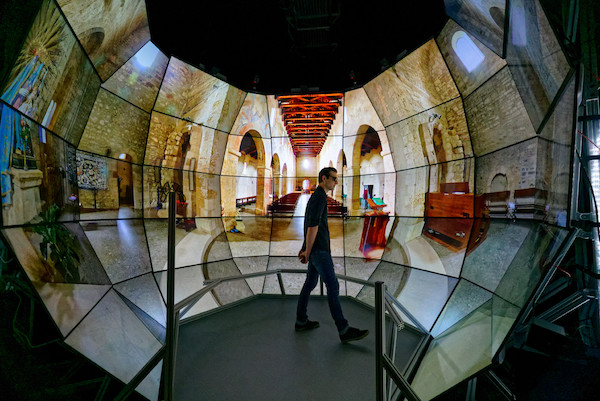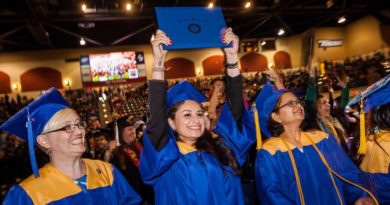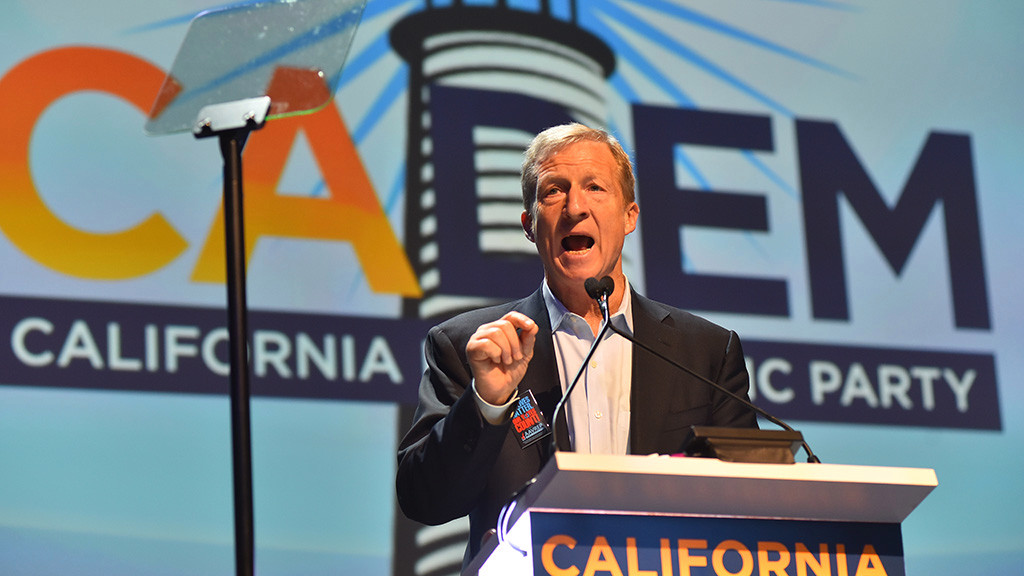Daily Business Report-Aug. 20, 2019
Joel Polizzi, visualization engineering technician at the Qualcomm Institute, stands in the middle of the SunCAVE that he helped construct (Photo courtesy of Falko Kuester)
Qualcomm Institute’s virtual reality
system, the SunCAVE, turns 2
By Katy E. Ismael | UC San Diego
Tucked into a cozy-feeling room on the first floor of the UC San Diego Qualcomm Institute’s Atkinson Hall are 70 screens, bundles of cables and 35 computer nodes that make up a powerful system that can process massive amounts of data transmitted over the Internet from researchers all over the US or even Antarctica.
It can also take you, virtually, into worlds as varied as a temple in Egypt, an ancient copper smelting site in Jordan or an underwater cave system on the Yucatan Peninsula. Or even into the abdomen of Crohn’s disease patients.
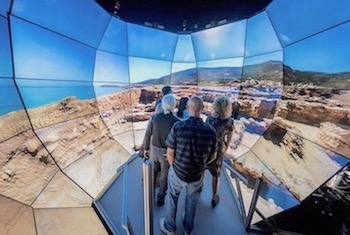
Front and center in the room is a 360-degree sphere-like scaffolding covered in screens called the SunCAVE—the world’s highest resolution walk-in virtual reality (VR) environment. It’s one that doctors, archaeologists, musicians, computer scientists and students are using to create new means for discovery, healing and understanding.
Two years ago this summer, the Qualcomm Institute’s CAVE (or Cave Automated Virtual Environment) morphed from the StarCAVE, as it was known, into the SunCAVE. Its physical shape changed, as did the technology running it behind the scenes.
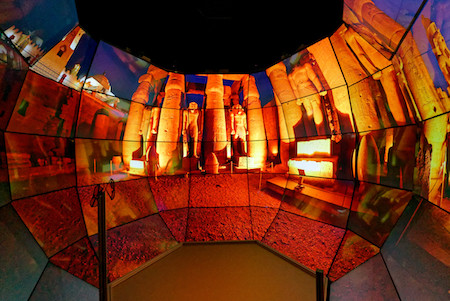
Tapping into the power of cluster computing, the SunCAVE today offers much more than just visuals; it’s become a powerful tool for machine learning and data analysis as well. Think of it as your TV being equipped with a supercomputer, becoming a visualization system that can also compute what it’s seeing. Only much bigger, brighter and faster— and connected to a host of other computers worldwide at speeds more than 1,000 times faster than your laptop.
_____________________
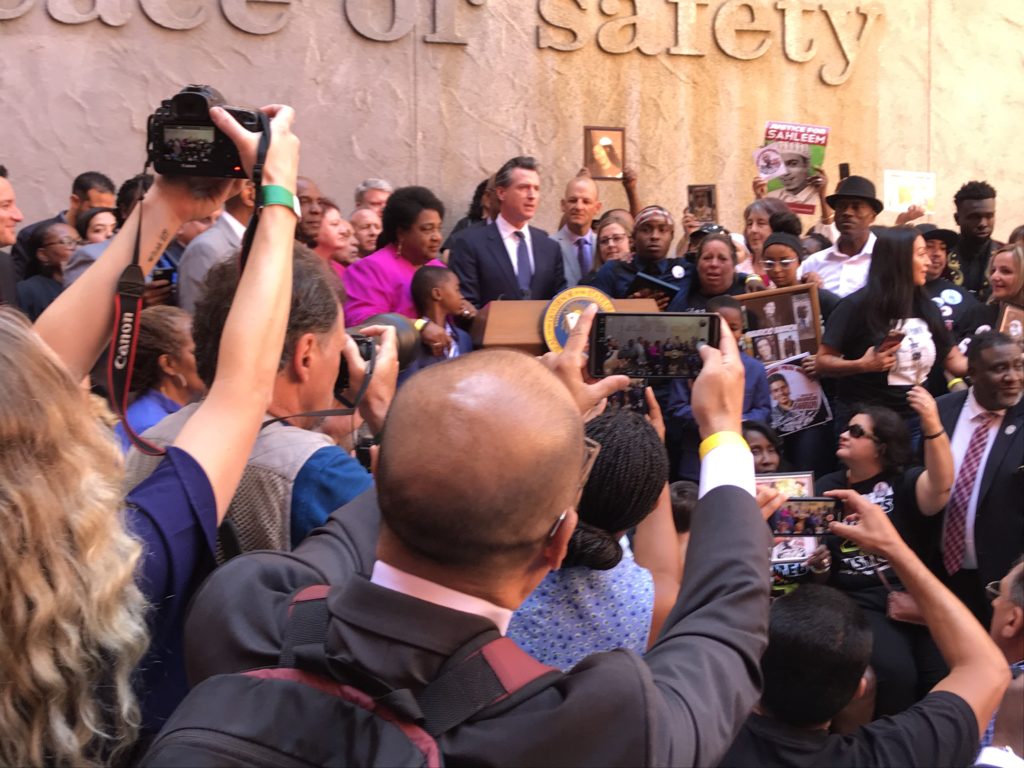
Governor signs landmark police use-of-force bill
By Dan Morain and Laurel Rosenhall | CALmatters
California will soon have a tougher new legal standard for the use of deadly force by police, under legislation Gov. Gavin Newsom signed Monday that was inspired by last year’s fatal shooting of a young, unarmed man in Sacramento.
Newsom signed the legislation amid unusual fanfare, convening numerous legislators, family members of people who have died in police shootings and advocates including civil-rights leader Dolores Huerta in a courtyard at the Secretary of State’s building used in the past for inaugurations and other formal events.
The governor contends that with Assembly Bill 392 in place, police will turn increasingly to de-escalation techniques including verbal persuasion, weapons other than guns and other crisis-intervention methods.
“It is remarkable to get to this moment on a bill that is this controversial. But it means nothing unless we make this moment meaningful,” Newsom said after signing the legislation.
“This will make a difference not only in California, but we know it will make a difference around the world,” said Assemblywoman Shirley Weber, the San Diego Democrat who carried the legislation.
_____________________
USD and San Diego County
launch small business accelerator
The University of San Diego and San Diego County Supervisor Nathan Fletcher announced the launch of Innovate Up, a new public-private partnership to provide a free, immersive and integrated small business program designed to support those in the communities of Chollas, City Heights, Encanto, Linda Vista (home of USD campus), Rolando and Redwood Village.
Innovate Up received a $300,000 County of San Diego Community Enhancement grant and combined with funding from multiple entities within USD and beyond, Fletcher and Harris confirmed that $1.5 million has been invested to support it.
The focus is on helping people with the verticals of success for small businesses, including ideation, business formation, branding, product development, marketing, finance, manufacturing, distribution and legal support. Innovate Up is for start-up businesses and existing businesses in these specific communities can get advice on scaling up.
_____________________

San Diego State releases football stadium renderings
NBC San Diego
The San Diego State University Athletics Department released renderings of what they hope the 35,000-seat stadium they want to build in Mission Valley is going to look like.
In 2016 voters awarded SDSU the ability to redevelop 132 acres of land where SDCCU Stadium now sits. Part of that plan is a new home for SDSU’s football program.

The Aztecs want to have it ready by the start of the 2022 college football season and are hoping to lure professional soccer, concerts and major NCAA events.
SDSU says part of the stadium plan does include potential expansion to 55,000 seats if a National Football League team ever returns to San Diego.
_____________________
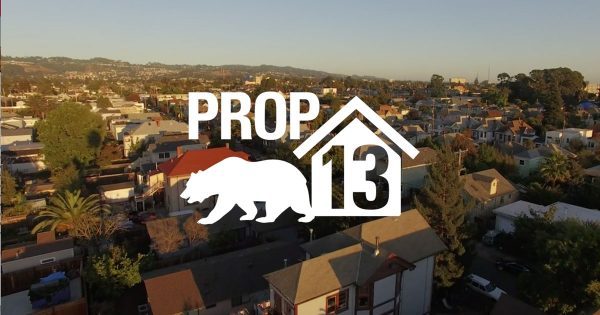
Burning money over Proposition 13
Public employee unions and others including a foundation established by Facebook founder Mark Zuckerberg spent $3.68 million in 2018 to qualify an initiative for the 2020 ballot to overhaul Proposition 13, the 1978 landmark initiative that cut property taxes.
They abandoned the initiative last week, essentially burning the millions they spent qualifying it for the ballot.
Backers announced they’ve filed a re-do, believing it would be more popular with the electorate. They have about $1.9 million so far to pay for signature gathering to place the do-over on the 2020 ballot.
Gov. Gavin Newsom sees an opportunity to use the property tax overhaul as leverage for a big tax rewrite, as The L.A. Times’ John Myers reports:
“My desire is to use this as an exercise in bringing the parties together to see if we can compromise on a more comprehensive tax package.”
— Dan Morain, CALmatters
_____________________
San Diego Green Building Council expands partnerships
The nonprofit San Diego Green Building Council (SDGBC) has launched a rebranding and strategic partnership realignment for the organization in a move to strengthen and expand its local impact. Now, in addition to its role with the national U.S. Green Building Council(USGBC) community, SDGBC is an official partner of the International Living Future Institute (ILFI) and host to the San Diego Living Future Collaborative. It will continue to operate under the San Diego Green Building Council name.
The rebranding process is the culmination of more than three years of input-gathering from the organization’s board of directors, staff, members and supporters. SDGBC’s mission and vision will remain the same, and its affiliation with the national USGBC community will continue. The rebranding process reflects the organization’s commitment to fostering additional national partnerships, such as with IFLI, to strengthen the regenerative impact of San Diego’s built environment, social well-being and ecosystems in the years ahead.
SDGBC and the Living Future Collaborative are hosting a series of roundtable events on various sustainability focus areas. The next roundtable event will focus on water issues on Sept. 10, with future panels to discuss materials, health and social equity topics.
_____________________
First app-based shuttle service launched in Carlsbad
The Carlsbad Connector, an on-demand shuttle service that transports commuters between the Carlsbad Poinsettia Coaster Station and workplaces in Carlsbad, officially launched on Monday. As the first program of its kind in San Diego County, the pilot service is designed to increase Coaster ridership by providing a flexible and convenient solution to bridge the gap between the station and the city’s primary industrial and commercial cores.
The innovative project is operated by a partnership with the city of Carlsbad, North County Transit District (NCTD) and the San Diego Association of Governments (SANDAG). The Carlsbad Connector functions via a smartphone app, similar to ride hailing service apps, developed by RideCo with shuttles operated by WeDriveU.
Commuters can book trips on 12-passenger vans that will shuttle them between the Poinsettia Coaster station and business parks near Palomar-McClellan Airport and along Avenida Encinas. Employees will be dropped off within a short walk from their destination.
The shuttles will service commuters from the Poinsettia Coaster station from 7 to 9 a.m. and 3 to 6 p.m. To accommodate lunchtime transportation, Carlsbad Connector will also provide service from noon to 3 p.m. from employment centers to local restaurants.
The Carlsbad Connector app is available for both iPhone and Android users. Commuters who cannot access the app through a smartphone can book a ride by calling 760-407-6080.
_____________________
Personnel Announcements
Stephanie Downer joins Seltzer Caplan McMahon Vitek
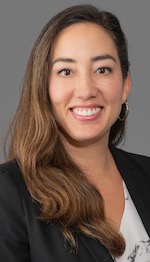
Stephanie S. Downer has joined the San Diego-based law firm of Seltzer Caplan McMahon Vitek as of counsel. Downer’s practice focuses on estate planning, wealth transfer planning, trust administration and probate law.
She has more than 12 years of experience representing families and business owners in all aspects of estate planning, including revocable living trust plans, gift and estate tax planning, charitable gift planning, property tax planning, trust administration and probate.
Prior to joining the firm, Downer was a partner at Paeske Law where she focused on estate planning, tax and business planning for clients in the San Diego community.
Downer is a member of the Trust and Estates Section of the State Bar of California and the Estate Planning, Trust and Probate Section of the San Diego Bar Association. She is also on the Estates and Trusts Council for the Rady Children’s Hospital Foundation and a member of the North County Estate Planning Council and Lawyers Club of San Diego.
She received her J.D. and LL.M. in taxation from the University of San Diego and her B.A. from the University of California, Santa Barbara. She spent nearly three years studying applied mathematics and computer science at New York University.
_____________________
Telemundo 20 San Diego names
Rigo Villalobos anchor/reporter

Telemundo 20 San Diego / KUAN named Rigo Villalobos anchor/reporter for the station’s newscasts that air Monday to Friday at 5:30 p.m., 6 p.m. and 11 p.m. Telemundo 20 serves the Spanish speaking community on the border between Tijuana and San Diego.
Villalobos has more than 10 years of experience working in local TV stations in Los Angeles, San Antonio and Las Vegas. He has been a part of the Telemundo stations family for over four years. Villalobos joined KUAN in 2017 as part of Telemundo 20’s launch team. At Telemundo 20, Villalobos has covered numerous local stories including the case of a 9-year-old girl who was detained at the border for 30 hours despite being a U.S. citizen. His exclusive story drew national attention as national immigration issues unfolded in the San Diego/Tijuana area.
A multi-Emmy Award winner, Villalobos earned a bachelor’s degree from California State University Northridge and became a United States citizen in 2019.

